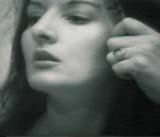Playback
Paul Murphy fast-forwards to the ICA exhibition Video Acts, which looks at performance-based artists’ videos from the past 35 years

There’s a neat parallel in the evolution and appearance of video artists in the mid-1960s and the continuing development of what it means to be a designer in the digital age. While the elder generation of graphic designers may still maintain that the computer is wholly exterior to the creative process, a visit to any art and design college in the country reveals an integration of what it is to be digital and what it is to be a designer.
Returning to the mid-1960s (one version of the origins of video art places it with Nam June Paik’s recording of the Pope’s visit to New York City and the subsequent playing of the tapes later in the day in a Greenwich Village café), the evolutionary moment was the arrival of the Sony Portapak, a relatively lightweight and inexpensive video camera.
The Portapak was revolutionary in that although it was only black and white, it used reel-to-reel videotape and consisted of a camera and a separate recording unit. Its portability and ease of operation meant that it was now possible to shoot video pieces outside the restrictions of the TV studio. While guerilla film-makers such as Videofreex took to the streets, artists largely disappeared into their studios to experiment with the technology and the possibilities of incorporating it into the creative process.
Video Acts at London’s Institute of Contemporary Arts examines this rich vein of performance-based artists’ videos from the past 35 years and was curated and designed by Klaus Biesenbach with Barbara London and Christopher Eamon.
The show includes pieces by Bill Viola, Bruce Nauman, Martha Rosler and Vito Acconci. The selection largely focuses on specific artists’ output rather than a democratic, evenly represented spread. So, for example, the upstairs gallery is largely split between 21 Naumans on one side and 18 Acconcis on the other, separated by a meagre pair of Dan Grahams.
The range of work goes from the frankly quite harrowing – performance artists Marina Abram-ovic and Ulay’s Breathing In, Breathing Out in which they each only breathe the other’s exhaled breath until they pass out – to the playful – witness William Wegman’s films of his Weimaraner dog Man Ray. Many of the early videos are distinguished by the fact that in the absence of an easy method of editing they run a full 30 or 60 minutes (the amount of tape on a reel-to-reel set up).
‘Each piece is projected or shown on a trolley-mounted monitor on wheels,’ says the ICA senior exhibitions organiser Simon Willis. ‘Things can be moved to make it as user-friendly and as engaging as possible and the show will be lit simply by the ambient light fro
m the projections and monitors. It’s a much more sympathetic way of showing the work rather than looped tapes.’
The show will also be an interesting test of the refurbishment of the ICA’s galleries that is currently taking place under the auspices of Trevor Horne Architects – which is responsible for the ultra-slick refit of the Victoria Miro gallery.
‘The sign of a good gallery is its invisibility,’ according to Willis. ‘Everything has to be in the service of the artwork and potentially this is the sort of show that will sustain people – it’s full of things that many will know of already, but won’t ever have had the chance to see properly before.’
Video Acts: Single Channel Works from the Collections Of Pamela and Richard Kramlich and New Art Trust shows in the ICA’s Concourse Gallery from 30 July to 19 October. The book Video Art by Michael Rush is published on 28 September by Thames & Hudson, priced £28
-
Post a comment




